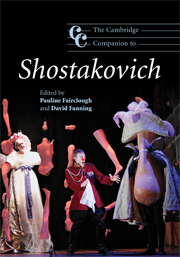10 - Between reality and transcendence: Shostakovich's songs
from PART III - Vocal and choral works
Published online by Cambridge University Press: 28 September 2011
Summary
Although reception history has given pride of place to Shostakovich's impressive double set of fifteen symphonies and string quartets, he was anything but a genre specialist. On the contrary, he adhered more strictly than any of his contemporaries to the traditional role of the composer as competent and active in all genres and modes of expression. Song writing was an area for which he showed special affinity. With twenty opus numbers devoted to solo vocal pieces (including the Fourteenth Symphony, which is a song cycle in all but name), a handful of unnumbered songs, and a significant element of vocal writing in his theatre and film scores, his place in the history of twentieth-century song can hardly be questioned.
Shostakovich wrote songs throughout his career, with a particularly high concentration in his later years. It has rightly been observed that ‘from 1960 until his death the relationship between vocal and instrumental music is virtually in balance’, and in this latest phase of his development he turned the genre of the song cycle – without ever using that specific term – into a flexible and multi-layered means of expression for his autobiographical and philosophical musings. But it should come as no surprise that the earliest work to show signs of his distinctive musical voice is also a set of songs: Two Fables of Krïlov, op. 4. Composed during his student years, these were a logical outcome of his conservatoire training, in which exercises in word-setting on the basis of the Russian literary classics were normal practice.
- Type
- Chapter
- Information
- The Cambridge Companion to Shostakovich , pp. 229 - 258Publisher: Cambridge University PressPrint publication year: 2008

